VDI Tools in 2025? 10 Solutions and Alternatives to Know

What Are Virtual Desktop Infrastructure (VDI) Tools?
VDI (Virtual Desktop Infrastructure) tools enable the central management and delivery of virtual desktops to remote users. Common VDI solutions include Citrix Virtual Apps and Desktops, Omnissa Horizon (formerly VMware Horizon), and Amazon WorkSpaces. While VDI tools provide a scalable solution for remote access, they are widely considered a legacy technology, due to their complexity and the high-latency, substandard end-user experience they provide.
Key features of VDI include:
- Centralized management: DI allows IT teams to manage and update virtual desktops from a central location, simplifying administration and reducing costs.
- Security: By centralizing data and applications, VDI can improve security and reduce the risk of data breaches.
- Device accessibility: VDI enables users to access their desktops and applications from different devices.
- High availability: Redundancy features ensure desktops remain accessible during outages.
- Persistence: Users can retain settings and data across sessions if configured.
- Integration: VDI platforms connect with identity services and enterprise systems.
- Monitoring and analytics: IT teams can track usage and performance in real time.
In this article:
Why Are VDI Tools Falling Out of Favor?
VDI tools were built to centralize desktop management and secure remote work, but their architecture has become a liability in modern work environments. The core problem is performance. Since every user interaction has to travel across a network to a remote data center and back, users are met with sluggish desktops, laggy logins, and choppy video calls. These issues reduce productivity and lead users to bypass IT controls, introducing new security risks.
As remote and hybrid teams grow, often across geographies and on personal devices, the performance strain worsens. Bandwidth limits, overloaded servers, and slow storage systems all contribute to an unreliable user experience. IT teams end up buried in support tickets and stuck in a cycle of constant tuning just to maintain acceptable performance.
Fixes like network optimizations or hardware upgrades can help temporarily, but they don’t address the root issue: VDI’s reliance on centralized infrastructure. For many organizations, the operational complexity, high costs, and poor user experience no longer justify keeping VDI in place, especially when modern alternatives are available that offer security without the performance tradeoffs.
Related content: Read our guide to VDI security
Frustrated by Lag and Latency from VDI/DaaS?
Discover how Venn’s local-first approach secures remote workforces without the complexity and latency of traditional VDI.
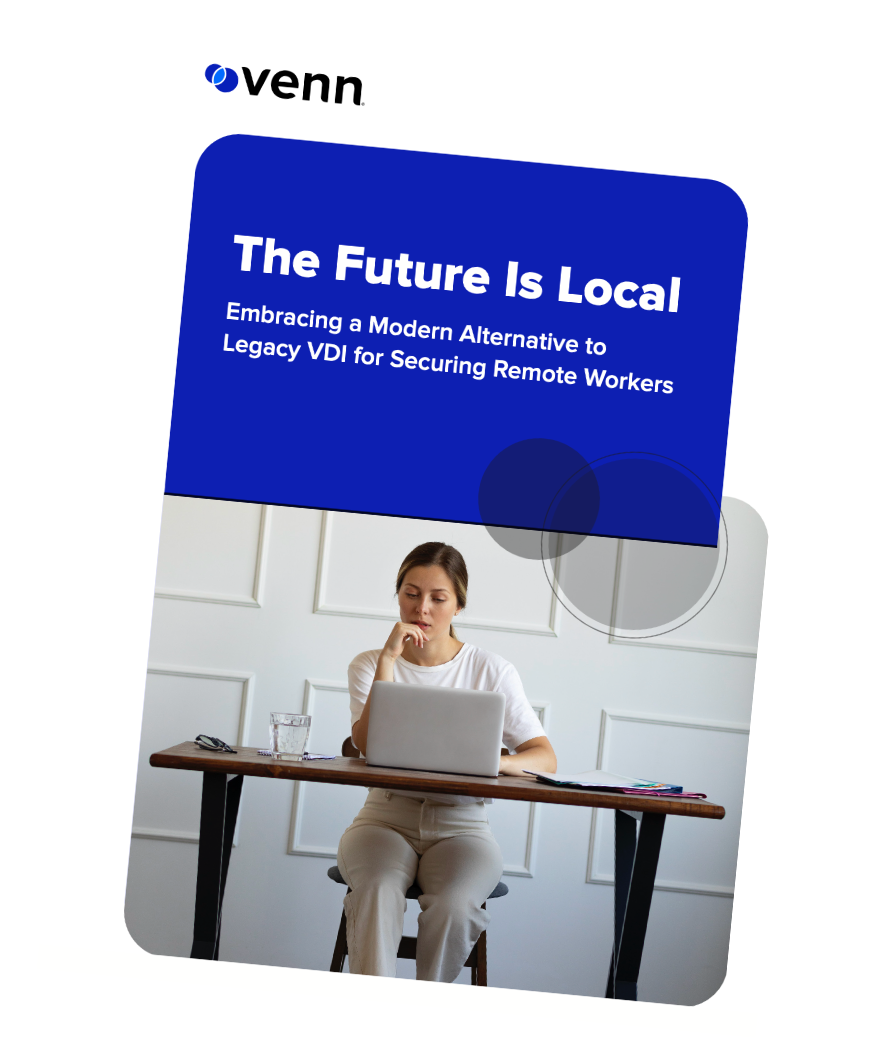
Notable VDI Alternatives
1. Venn

Venn’s Blue Border was purpose-built to protect company data and applications on BYOD computers used by contractors and remote employees – without VDI.
Similar to an MDM solution but for laptops, work lives in a company-controlled Secure Enclave installed on the user’s PC or Mac, where all data is encrypted and access is managed. Work applications run locally within the Enclave – visually indicated by Venn’s Blue Border™ – protecting and isolating business activity while ensuring end-user privacy.
With Venn, you can eliminate the burden of purchasing and securing laptops and managing virtual desktops (VDI.) Unlike virtual desktops, Venn keeps users working locally on natively installed applications without latency – all while extending corporate firewall protection to business activity only.
Key features include:
- Secure Enclave technology: Encrypts and isolates work data on personal Mac or PC computers, both for browser-based and local applications.
- Zero trust architecture: Uses a zero trust approach to secure company data, limiting access based on validation of devices and users.
- Visual separation via Blue Border: Visual cue that distinguishes work vs. personal sessions for users.
- Supports turnkey compliance: Using Venn helps companies maintain compliance on unmanaged Macs with a range of regulatory mandates, including HIPAA, PCI, SOC, SEC, FINRA and more.
- Granular, customizable restrictions: IT teams can define restrictions for copy/paste, download, upload, screenshots, watermarks, and DLP per user.
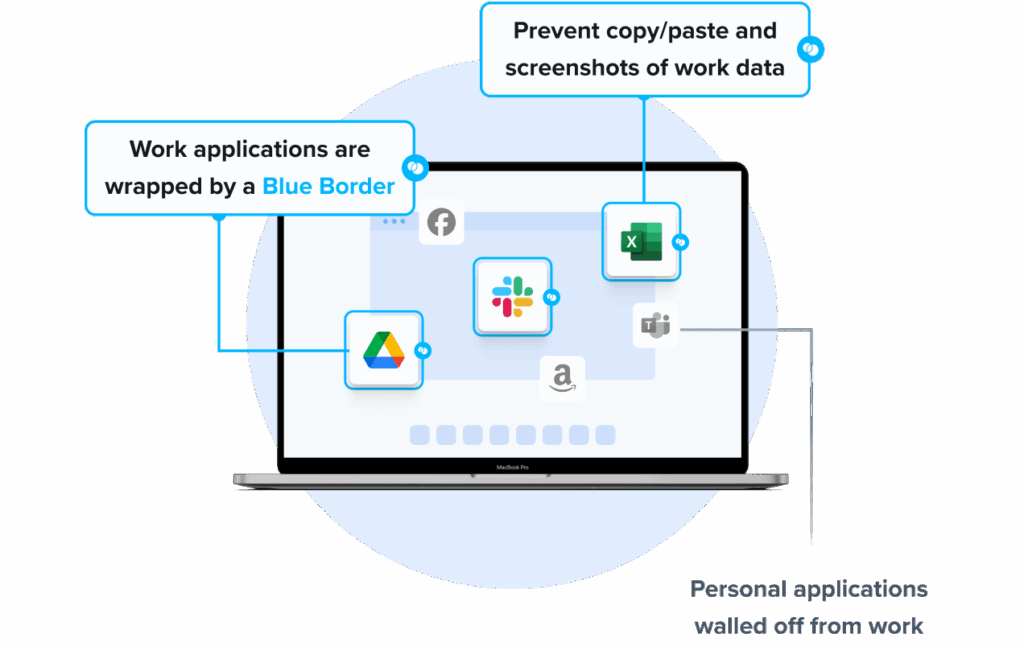
2. Prisma Browser

Prisma Browser is a secure enterprise browser natively integrated with Prisma SASE. It extends zero trust access, data controls, and threat prevention to managed and unmanaged devices, supporting BYOD and reducing reliance on traditional VDI.
Key features include:
- SASE-native secure browsing: Integrates directly with SASE to apply consistent security, access policies, and data protections across users, apps, and networks.
- Zero trust access controls: Enforces granular, least-privileged access policies for web and private applications across contractors, partners, and independent workers on any device.
- BYOD enablement: Applies enterprise controls to personal devices, securing data and web activity without requiring full device management or traditional VDI agents.
- Visibility and session control: Provides browser-level visibility, policy enforcement, and controls over user actions to align activity with security requirements and governance.
- Threat prevention services: Leverages cloud defenses to block malicious files and URLs, reducing exposure to phishing, malware, and evasive web-based attacks.
- VDI reduction use case: Replaces VDI for many web and SaaS scenarios, lowering operational complexity while maintaining controls for remote access.
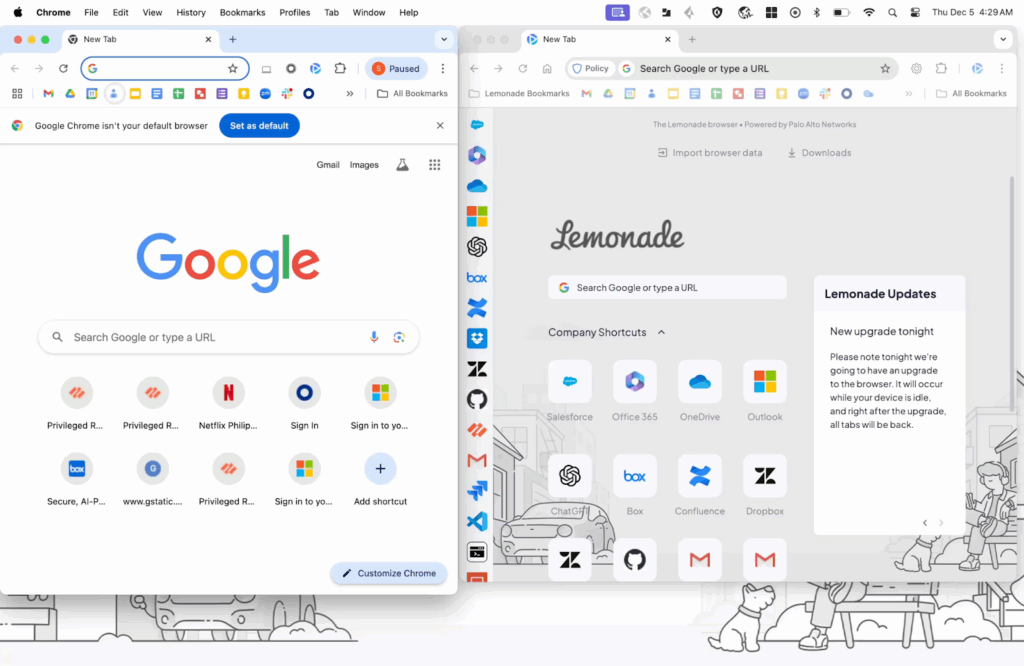
Source: Palo Alto Networks
3. Menlo Secure Enterprise Browser

Menlo Secure Enterprise Browser applies browser isolation, network separation, and advanced malware defenses to make zero trust practical in the browser. It standardizes security policies, protects data “to the last mile,” and adds forensics and posture management.
Key features include:
- Isolation-first architecture: Uses cloud-based browser isolation and network separation so active web content never executes on endpoints, reducing attack surface significantly.
- HEAT Shield AI protections: Detects highly evasive threats and zero-hour phishing, blocking malicious content and drive-by attacks that bypass legacy detection tools.
- Zero trust application access: Delivers least-privileged access to private and SaaS apps in the browser, limiting lateral movement compared to traditional VPN approaches.
- Browser posture management: Automates benchmark-aligned configurations, generating compliant browser policies to reduce misconfigurations across Chrome and Edge fleets.
- Last-mile data controls: Applies granular policies for data handling in the browser, supporting information leakage prevention and consistent governance for hybrid work.
- Browsing forensics and visibility: Captures session activity for investigation and compliance, improving oversight without disrupting native user experiences.
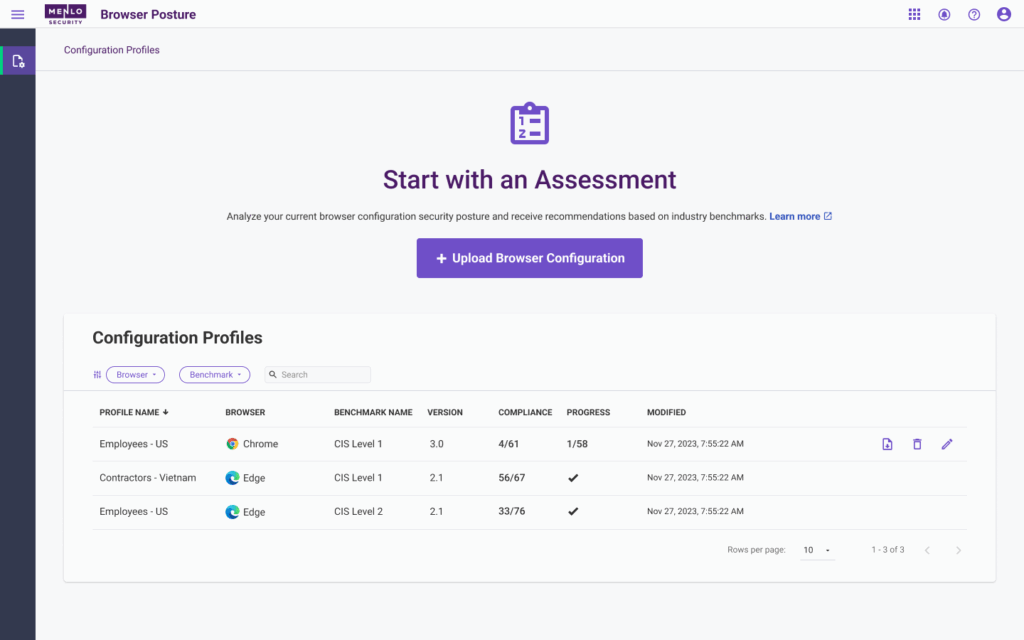
Source: Menlo Security
Notable VDI and Desktop as a Service (DaaS) Tools
If your organization is still investing in the VDI/DaaS paradigm, here are the popular solutions on the market today.
4. Citrix

Citrix provides a virtual desktop and application delivery platform to support distributed workforces while maintaining security and management control. It offers cloud-based Citrix DaaS and on-premises Citrix Virtual Apps and Desktops, allowing organizations to deploy in hybrid or multi-cloud setups.
Key features include:
- Centralized management: Unified console to manage virtual desktops and applications across cloud, on-premises, or hybrid environments.
- Secure access controls: Granular security policies, analytics, and session recording to protect sensitive data and unmanaged endpoints.
- Flexible deployment options: Support for cloud, on-premises, and hybrid infrastructure, enabling tailored deployment strategies.
- Hybrid multi-cloud support: Delivery of apps and desktops across multiple clouds.
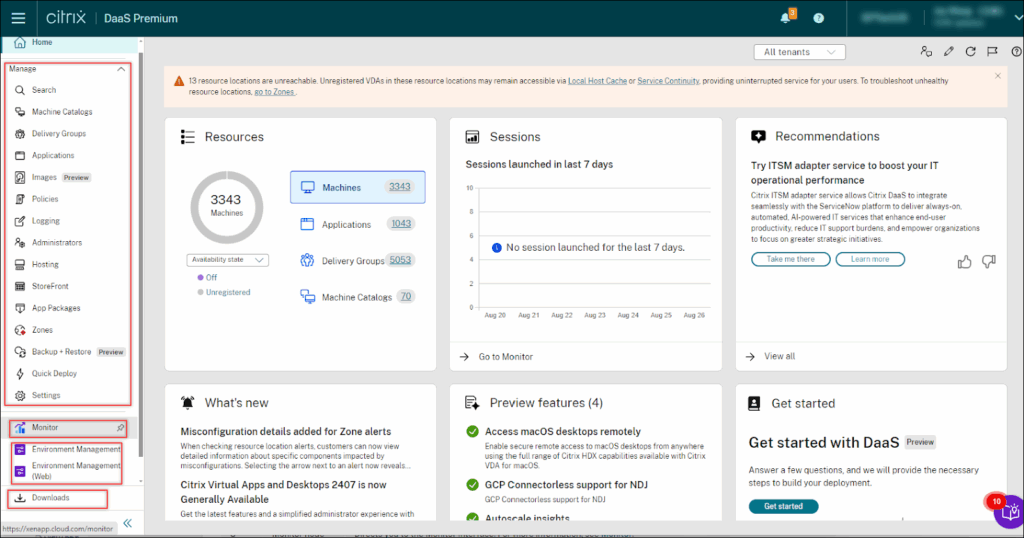
Source: Citrix
5. Omnissa Horizon

Omnissa Horizon (formerly VMware Horizon) is a desktop and application virtualization platform that delivers Windows, Linux, and macOS desktops through VMware’s virtualization stack. It runs desktop operating systems inside virtual machines on a hypervisor and transports the user interface over the network using protocols such as Blast Extreme, PCoIP, or RDP.
Key features include:
- VMware vSphere integration: Uses ESXi hypervisor and vCenter Server for virtual desktop provisioning and management.
- View Composer: Provides automated desktop creation and cloning for deployment.
- View Manager: Centralized administration console for managing the Horizon environment.
- Application virtualization: Delivered through VMware ThinApp to package and run apps independently of the underlying OS.
- User profile management: View Persona Management ensures user settings and data follow users across sessions.

Source: Omnissa
6. Amazon WorkSpaces

Amazon WorkSpaces is a cloud-native virtual desktop service that delivers secure desktops to users from different locations. Built on AWS, it enables organizations to provide cloud-hosted desktops without the need to manage on-premises VDI infrastructure. WorkSpaces integrates with existing enterprise tools and licensing, including Microsoft 365 Apps for enterprise.
Key features include:
- Cloud-native virtual desktops: Fully managed desktop environments hosted on AWS.
- WorkSpaces Core: Provides APIs and infrastructure for integration with third-party VDI tools like Citrix, Omnissa, and Workspot.
- WorkSpaces Secure Browser: Delivers a cloud-based browser for secure access to web applications.
- WorkSpaces Thin Client: Secure hardware option for connecting to virtual desktops.
- Enterprise security: Built on AWS infrastructure with strong security controls and compliance certifications.

Source: Amazon
7. Azure Virtual Desktop

Azure Virtual Desktop (formerly Windows Virtual Desktop) is Microsoft’s cloud-based desktop and application virtualization service hosted on Azure. It allows organizations to deliver Windows 11, Windows 10, or Windows Server desktops, either as single-session for dedicated use or multi-session for scalable deployments.
Key features include:
- Windows multi-session support: Windows 11/10 Enterprise multi-session capability reduces VM overhead while serving multiple users.
- Flexible delivery options: Publish full desktops or deliver individual apps through RemoteApp.
- Microsoft 365 optimization: Run Microsoft 365 Apps for enterprise in multi-user virtual scenarios with performance enhancements.
- Application compatibility: Support for Win32, MSIX, and Appx application formats, along with custom line-of-business apps.
- Hybrid deployment: Extend environments on-premises with Azure Local in a hybrid configuration.

Source: Microsoft
8. VirtualBox

Oracle VirtualBox is a hosted hypervisor that runs on Windows, macOS, Linux, Solaris, and several other platforms, enabling users to create and manage virtual machines across operating systems. Originally developed by InnoTek and later acquired through Sun Microsystems, VirtualBox has evolved into an open-source virtualization solution with optional extensions.
Key features include:
- Cross-platform host support: Runs on Windows, Linux, macOS, Solaris, and ports to FreeBSD and Genode.
- Wide guest OS compatibility: Supports Windows, Linux, BSD, Solaris, Haiku, OS/2, and experimental macOS virtualization.
- Guest additions: Provides drivers and utilities for better performance, graphics acceleration, dynamic resolution changes, and shared folders.
- Snapshots and rollback: Capture VM state and revert to earlier snapshots for testing or recovery.
- Device and peripheral emulation: Emulates storage (VDI, VMDK, VHD), network adapters, sound cards, and USB devices.
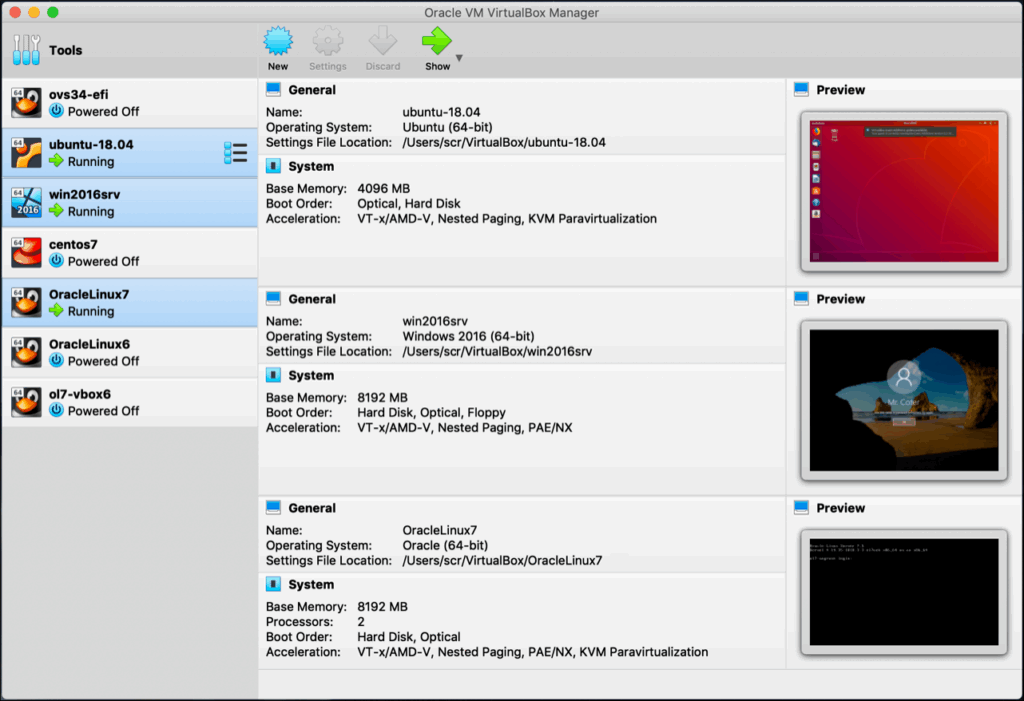
Source: Oracle
9. Parallels RAS

Parallels RAS (Remote Application Server) is a virtual application and desktop delivery solution for management and secure remote access. It supports hybrid deployments across on-premises, private cloud, and public cloud infrastructure, with integrations for Azure Virtual Desktop and AWS.
Key features include:
- Flexible deployment: Supports hybrid, on-premises, and multi-cloud environments with Azure Virtual Desktop and AWS integrations.
- Device and browser support: Clients for Windows, macOS, Linux, iOS, Android, and HTML5 browsers enable access from any device.
- Unified management console: Single-pane administration for apps, desktops, load balancing, authentication, and reporting across sites and data centers.
- Application and desktop delivery: Publish virtual apps or full desktops with built-in MSIX App Attach, App-V, and FSLogix support.
- Dynamic scalability: Automatically adjusts resources and supports multi-tenancy without additional infrastructure components.
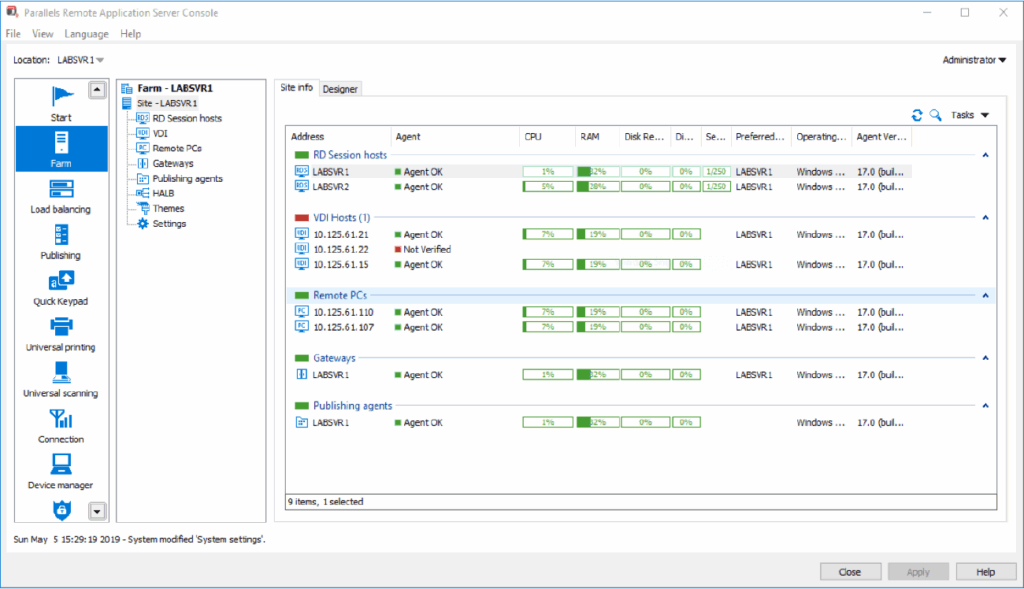
Source: Parallels
10. Kasm Workspaces

Kasm Workspaces is a cloud-native platform that delivers containerized desktops and applications through the browser, replacing traditional VDI agents or endpoint installations. Built on containerization, Kubernetes orchestration, and microservices, it provides a secure environment for remote work, secure browsing, and application delivery.
Key features include:
- Cloud-native delivery: Containerized desktops and applications delivered through the browser with no endpoint agent installation.
- Kubernetes orchestration: Scalable and resilient architecture using containers and microservices.
- Multi-device access: Users connect from different devices with a web browser, supporting remote and hybrid work models.
- Enterprise security: SSO via SAML (Azure AD, Okta, Google Workspace), optional two-factor authentication, and compliance-ready design.
- Data loss prevention: Administrative controls for clipboard, file transfers, USB access, and application restrictions.

Source: Kasm
Key Considerations and Challenges When Deploying VDI
For organizations still committed to using VDI, it’s important to understand the limitations and operational burdens that come with it. Despite offering centralized management and security, VDI introduces significant challenges that can outweigh its benefits.
Key considerations include:
- High infrastructure costs: VDI requires substantial investment in servers, storage, licensing, and network equipment, especially when deployed on-premises or in hybrid environments.
- Complexity of management: Administering a VDI environment demands specialized knowledge in networking, virtualization, storage, and identity management. Even small changes often require coordination across multiple teams.
- User experience degradation: Network latency, bandwidth constraints, and shared infrastructure frequently result in sluggish performance, impacting productivity and increasing dissatisfaction among users.
- Support overhead: VDI environments are prone to frequent issues, from login delays to profile corruption, leading to a high volume of IT support tickets and reactive troubleshooting.
- Limited offline access: Since desktops run in remote data centers, users must be connected to work. This dependence on connectivity makes VDI unsuitable for users who need offline access.
- Scalability challenges: Scaling requires adding backend resources, which can be time-consuming and expensive, especially during sudden shifts in workforce size or remote access needs.
- Security gaps from misconfiguration: While VDI centralizes control, improper setup or outdated components can expose systems to attacks or data leaks.
Conclusion
VDI tools were built for a different era, when controlling desktops from a central location made sense. Today’s distributed workforce, dominated by personal devices, cloud-native apps, and dynamic work patterns, demands a different approach.
Modern solutions like Venn deliver the same security and control without the complexity, performance issues, or infrastructure costs of VDI. Instead of investing in outdated, high-maintenance technology, organizations can adopt these newer approaches to secure work without compromising user experience. For most use cases, it makes more sense to move on from VDI than to double down on it.